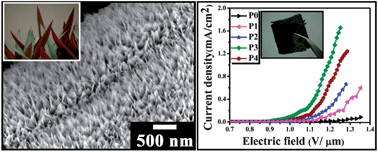Highly oriented cupric oxide nanoknife arrays on flexible carbon fabric as high performing cold cathode emitter†
Abstract
Sharp knife edged copper oxide (CuO) nano architectures were directly grown on the surface of flexible carbon fabric by a facile chemical route with the assistance of nonionic surfactant PEG-6000. The carbon fabric substrate preserves its high flexibility even after the growth of the entire nanostructure. Moreover, it can be rolled-up and twisted to a large degree without affecting the electrical characteristics. The phase purity and degree of crystallinity of the developed nanostructures were systemically supported by X-ray diffraction, X-ray photoelectron spectroscopy, field emission scanning electron microscopy and high-resolution transmission electron microscopy. A proposed growth mechanism has been offered by thoroughly analyzing the field emission scanning electron microscopic images of the nanostructures grown at different concentrations of PEG. Among the as grown nanostructures, copper oxide nanoknives have exhibited remarkable field emission properties and high stability with a lower turn-on field of 0.9 V μm−1 (10 μA cm−2) at room temperature, which is sufficient for electron emission based devices like field emission displays and vacuum nano-electronic devices.

- This article is part of the themed collection: Flexible Electronics

 Please wait while we load your content...
Please wait while we load your content...